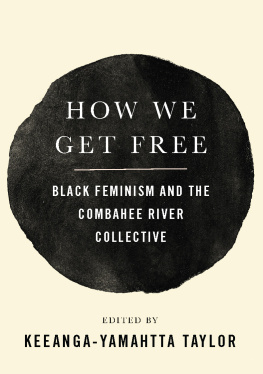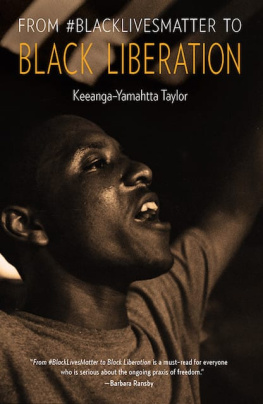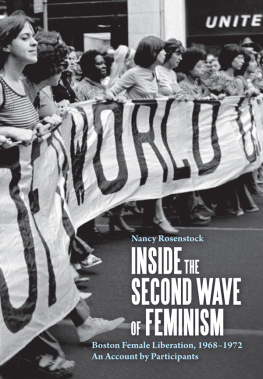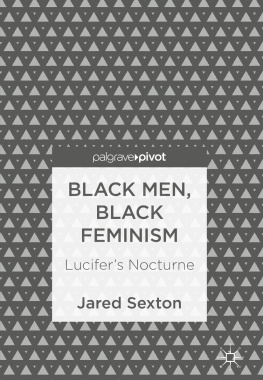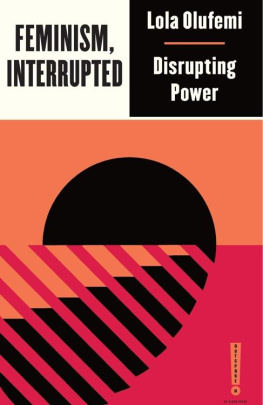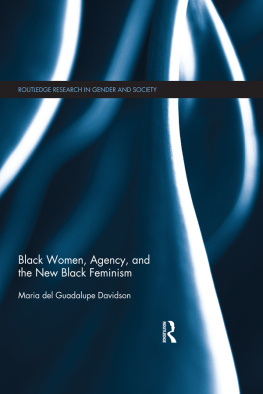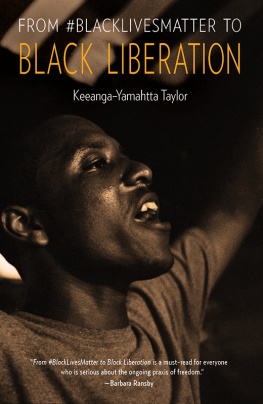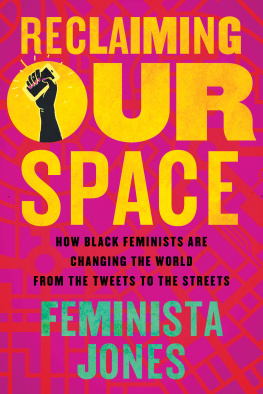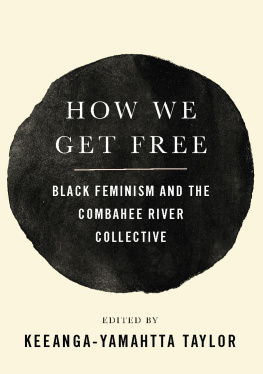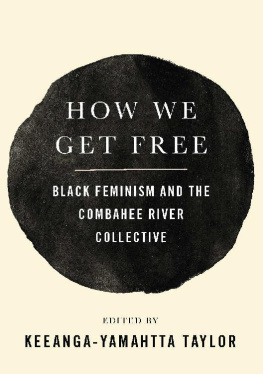Keeanga-Yamahtta Taylor - How We Get Free: Black Feminism and the Combahee River Collective
Here you can read online Keeanga-Yamahtta Taylor - How We Get Free: Black Feminism and the Combahee River Collective full text of the book (entire story) in english for free. Download pdf and epub, get meaning, cover and reviews about this ebook. year: 2017, publisher: Haymarket Books, genre: Politics. Description of the work, (preface) as well as reviews are available. Best literature library LitArk.com created for fans of good reading and offers a wide selection of genres:
Romance novel
Science fiction
Adventure
Detective
Science
History
Home and family
Prose
Art
Politics
Computer
Non-fiction
Religion
Business
Children
Humor
Choose a favorite category and find really read worthwhile books. Enjoy immersion in the world of imagination, feel the emotions of the characters or learn something new for yourself, make an fascinating discovery.
- Book:How We Get Free: Black Feminism and the Combahee River Collective
- Author:
- Publisher:Haymarket Books
- Genre:
- Year:2017
- Rating:3 / 5
- Favourites:Add to favourites
- Your mark:
- 60
- 1
- 2
- 3
- 4
- 5
How We Get Free: Black Feminism and the Combahee River Collective: summary, description and annotation
We offer to read an annotation, description, summary or preface (depends on what the author of the book "How We Get Free: Black Feminism and the Combahee River Collective" wrote himself). If you haven't found the necessary information about the book — write in the comments, we will try to find it.
How We Get Free: Black Feminism and the Combahee River Collective — read online for free the complete book (whole text) full work
Below is the text of the book, divided by pages. System saving the place of the last page read, allows you to conveniently read the book "How We Get Free: Black Feminism and the Combahee River Collective" online for free, without having to search again every time where you left off. Put a bookmark, and you can go to the page where you finished reading at any time.
Font size:
Interval:
Bookmark:
Contents
This eBook is licensed to Toby Smith, tlvs03@gmail.com on 03/19/2020
Introduction
In the days after the disastrous 2016 presidential election, a popular meme showing that 94 percent of Black women voters had cast their ballot for Hillary Clinton was circulated as proof that Black women had done their part to keep Trump out of the White House. The meme, though, was misleading. It was true that 94 percent of Black women who voted cast their ballot for Clinton, but those voters represented 64 percent of all eligible Black women. Even though this was a large voter turnout, it represented a 6 percent drop in Black womens historically high turnout in 2012, when Barack Obama was on the ballot. Indeed, the overall turnout for Black voters declined for the first time in a presidential election in twenty years, falling to 59 percent from its historic high of 66 percent in 2012.
The search for answers to how the loathsome Donald J. Trump could become president of the United States tended to focus on who did and did not vote. Of course that was part of the explanation, but what was often missing was closer scrutiny of what kept tens of millions of people from participating in the election. To that point, given Trumps repeated appeals to racism, why would fewer, not more, African Americans, including Black women, have participated in that critical election?
Any cursory investigation into the lives of African Americans would have revealed deep dissatisfaction with their conditionseven after the historic election of Barack Obama in 2008. After all, the last few years of the Obama presidency had seen the rise of the Black Lives Matter movement and an eruption of Black social protest. Indeed, a 2017 Power of the Sister Vote poll, conducted by the Black Womens Roundtable and Essence magazine, found an 11 percent drop between 2016 and 2017 in the support of Black women for the Democratic Party. The poll also reported that the percentage of Black women who feel that neither party supports them had jumped from 13 percent to 21 percent in the same time period.
To anyone who bothered to investigate the conditions in Black communities, these numbers should not be surprising. Looking at Black communities through the specific experiences of Black women would have revealed the depths of economic and social crisis unfolding in Black America. Black women had led the way in electoral support for Barack Obama, and with those votes came the expectation that life would improve. Instead of getting better, wages stagnated, poverty increased, and policing was an added burden. These very conditions explain why Black women have led the latest iteration in Black social protest.
In other words, Black womens experiences cannot be reduced to either race or gender but have to be understood on their own terms. For example, wage differentials between men and women are often used to demonstrate the persistence of sexism in the workforce. The main statistic cited is that women generally make 80 percent of what men make. If we looked even closer, we could see that in Louisiana, Black women were making 43 percent of what white men in that state make. And when you consider that in 80 percent of Black families, Black women are either the sole provider or the main provider, it brings into focus the economic hardship experienced by most Black families in this country. The same could be said of poverty. Black women make up 25 percent of the poor, compared to Black men, who are 18 percent; and to white women, who make up 10 percent of poor people. Thus, the inclusion of Black women on their own terms is not a concession to political correctness or identity politics; it is necessary to validate the particular experiences of Black women in our society while also measuring exactly the levels of oppression, inequality, and exploitation experienced in African American communities. More important, looking at the condition of Black women reveals the utter inadequacy of what qualifies as social welfare in the United States today.
The year 2017 marked the fortieth anniversary of the Combahee River Collective Statement, which introduced to the world terms such as interlocking oppression and identity politics. The Combahee River Collective (CRC) was a radical Black feminist organization formed in 1974 and named after Harriet Tubmans 1853 raid on the Combahee River in South Carolina that freed 750 enslaved people.
The CRC formed as a radical alternative to the National Black Feminist Organization (NBFO). The NBFO itself had formed in response to what Black feminists believed was the failure of white feminist organizations to adequately respond to racism in the United States. But the identification of racism alone as a phenomenon in the lives of Black women was politically insufficient as an analysis or as a plan of action.
It is difficult to quantify the enormity of the political contribution made by the women of the Combahee River Collective, including Barbara Smith, her sister Beverly Smith, and Demita Frazier, because so much of their analysis is taken for granted in feminist politics today. Take, for example, the ubiquity of the term intersectionality in mainstream political discourse. The Combahee women did not coin the phrase intersectionalityKimberl Crenshaw did so in 1989but the CRC did articulate the analysis that animates the meaning of intersectionality, the idea that multiple oppressions reinforce each other to create new categories of suffering.
The CRC described oppressions as interlocking or happening simultaneously, thus creating new measures of oppression and inequality. In other words, Black women could not quantify their oppression only in terms of sexism or racism, or of homophobia experienced by Black lesbians. They were not ever a single category, but it was the merging or enmeshment of those identities that compounded how Black women experienced oppression.
The women of the CRC were not the first Black women to recognize their position in American society. This historic insight was captured, perhaps most succinctly, by Black writer and public intellectual Anna Julia Cooper in 1892: The colored woman of to-day occupies... a unique position in this country.... She is confronted by both a woman question and a race problem, and is as yet an unknown or an unacknowledged factor in both. In the 1960s, Black feminist activists like Frances Beal described the oppression of Black women as double jeopardy, which also recognized the specificity of their compounded oppressions.
The Combahee River Collective built on those observations by continuing to analyze the roots of Black womens oppression under capitalism and arguing for the reorganization of society based on the collective needs of the most oppressed. That is to say, if you could free the most oppressed people in society, then you would have to free everyone. For the Combahee River Collective, this was not an academic exercise. Not only was it crucial to understanding the particular experiences of Black women as compared to white women and Black men, but it also created entry points for Black women to engage in politics. This was a critical aspect of the CRCs political intervention in the womens movement. One could not expect Black women to be wholly active in political movements that neither represented nor advanced their interests. The inability or unwillingness of most white feminist organizations to fully engage with antiracist issues affecting Black women, like campaigning against sterilization and sexual assault or for low-wage labor and workplace rights, alienated Black women and other women of color from becoming active in those organizations. The same was true within the Black liberation movement that was overwhelmingly dominated by Black men. Indeed, it was not unusual for Black male organizers to oppose abortion rights for Black women on the basis that abortion was genocide for Black people. Thus, the narrow agendas of white liberal feminist organizations and some purported Black radical organizations cut them off from a cadre of radical Black women who had been politically trained through their participation in the civil rights movement and the urban-based Black insurgency during most of the 1960s. The inattention to Black womens issues also cut them off from newly radicalizing Black women looking to become involved in political activism. In this context, the women of Combahee were not only making a political intervention into the feminist movement, but by doing so, they were also creating new entry points into activism for Black and Brown women who would have otherwise been ignored. This was borne out in Boston, for example, where the Combahee River Collective was centrally involved in campaigns against the sterilization of Black and Brown women, the abortion rights movement, and the emergent struggle against domestic violence. Of course, all of these women newly activated into the feminist movement did not join the CRC, yet the influence of that organization and the generalization of their analysis opened up the world of organizing and radical politics to new Black feminists.
Next pageFont size:
Interval:
Bookmark:
Similar books «How We Get Free: Black Feminism and the Combahee River Collective»
Look at similar books to How We Get Free: Black Feminism and the Combahee River Collective. We have selected literature similar in name and meaning in the hope of providing readers with more options to find new, interesting, not yet read works.
Discussion, reviews of the book How We Get Free: Black Feminism and the Combahee River Collective and just readers' own opinions. Leave your comments, write what you think about the work, its meaning or the main characters. Specify what exactly you liked and what you didn't like, and why you think so.

